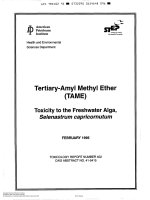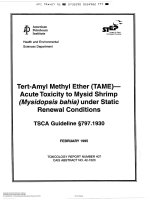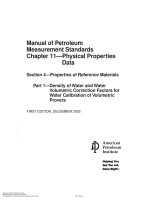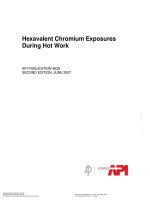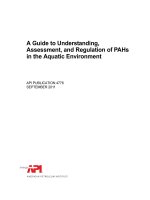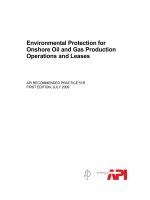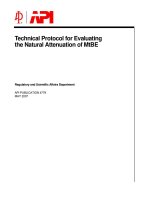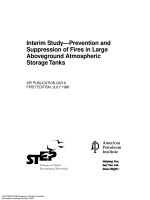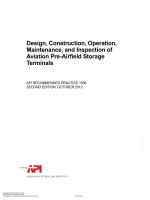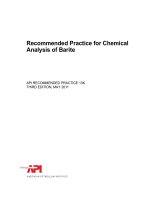Api api 579 1 2016 (american petroleum institute)
Bạn đang xem bản rút gọn của tài liệu. Xem và tải ngay bản đầy đủ của tài liệu tại đây (11.55 MB, 1,320 trang )
Fitness-For-Service
API 579-1/ASME FFS-1, June, 2016
[Intentionally Left Blank]
API 579-1/ASME FFS-1 2016 Fitness-For-Service
Foreword
In contrast to the straightforward and conservative calculations that are typically found in design codes, more
sophisticated assessment of metallurgical conditions and analyses of local stresses and strains can more
precisely indicate whether operating equipment is fit for its intended service or whether particular fabrication
defects or in-service deterioration threaten its integrity. Such analyses offer a sound basis for decisions to
continue to run as is or to alter, repair, monitor, retire or replace the equipment.
The publication of the American Petroleum Institute’s Recommended Practice 579, Fitness-For-Service, in
January 2000 provided the refining and petrochemical industry with a compendium of consensus methods for
reliable assessment of the structural integrity of equipment containing identified flaws or damage. API RP 579
was written to be used in conjunction with the refining and petrochemical industry’s existing codes for pressure
vessels, piping and aboveground storage tanks (API 510, API 570 and API 653). The standardized FitnessFor-Service assessment procedures presented in API RP 579 provide technically sound consensus
approaches that ensure the safety of plant personnel and the public while aging equipment continues to
operate, and can be used to optimize maintenance and operation practices, maintain availability and enhance
the long-term economic performance of plant equipment.
Recommended Practice 579 was prepared by a committee of the American Petroleum Institute with
representatives of the Chemical Manufacturers Association, as well as some individuals associated with
related industries. It grew out of a resource document developed by a Joint Industry Program on Fitness-ForService administered by The Materials Properties Council. Although it incorporated the best practices known
to the committee members, it was written as a Recommended Practice rather than as a mandatory standard or
code.
While API was developing Fitness-For-Service methodology for the refining and petrochemical industry, the
American Society of Mechanical Engineers (ASME) also began to address post-construction integrity issues.
Realizing the possibility of overlap, duplication and conflict in parallel standards, ASME and API formed the
Fitness-For-Service Joint Committee in 2001 to develop and maintain a Fitness-For-Service standard for
equipment operated in a wide range of process, manufacturing and power generation industries. It was
intended that this collaboration would promote the widespread adoption of these practices by regulatory
bodies. The Joint Committee included the original members of the API Committee that wrote Recommended
Practice 579, complemented by a similar number of ASME members representing similar areas of expertise in
other industries such as chemicals, power generation and pulp and paper. In addition to owner
representatives, it included substantial international participation and subject matter experts from universities
and consulting firms.
In June 2007, the Fitness-For-Service Joint Committee published the first edition of API 579-1/ASME FFS-1
Fitness-For-Service.
The 2016 publication of API 579-1/ASME FFS-1 includes a number of modifications and technical
improvements. Some of the more significant changes are the following:
•
Reorganized the standard to facilitate use and updates.
•
Expanded equipment design code coverage.
•
Added Annex for establishing an allowable Remaining Strength Factor (RSF).
•
Simplified Level 1 criterion for the circumferential extent of a Local Thin Area (LTA) through the
modification of the Type A Component definition and subdivision of Type B Components into Class 1
or Class 2.
•
Updated crack-like flaw interaction rules.
•
Re-wrote weld residual stress solution Annex for use in the assessment of crack-like flaws.
iii
API 579-1/ASME FFS-1 2016 Fitness-For-Service
•
Updated guidance on material toughness predictions for use in the assessment of crack-like flaws.
•
Updated evaluation procedures for the assessment of creep damage.
•
Added Annex covering metallurgical investigation and evaluation of mechanical properties in a fire
damage assessment.
•
Developed new Part 14 covering the assessment of fatigue damage.
This publication is written as a standard. Its words shall and must indicate explicit requirements that are
essential for an assessment procedure to be correct. The word should indicates recommendations that are
good practice but not essential. The word may indicate recommendations that are optional.
Most of the technology that underlies this standard was developed by the Joint Industry Program on FitnessFor-Service, administered by The Materials Properties Council. The sponsorship of the member companies of
this research consortium and the voluntary efforts of their company representatives are acknowledged with
gratitude.
The committee encourages the broad use of the state-of-the-art methods presented here for evaluating all
types of pressure vessels, boiler components, piping and tanks. The committee intends to continuously
improve this standard as improved methodology is developed and as user feedback is received. All users are
encouraged to inform the committee if they discover areas in which these procedures should be corrected,
revised or expanded. Suggestions should be submitted to the Secretary, API/ASME Fitness-For-Service Joint
Committee, The American Society of Mechanical Engineers, Two Park Avenue, New York, NY 10016, or
There is an option available to receive an e-mail notification when errata are posted to a particular code or
standard. This option can be found on the Committee Web at after selecting
“errata” in the “Publication Information” section.
This standard is under the jurisdiction of the ASME Board on Pressure Technology Codes and Standards and
the API CRE Committee and is the direct responsibility of the API/ASME Fitness-For-Service Joint Committee.
The American National Standards Institute approved API 579-1/ASME FFS-1 2016 in June, 2016.
Although every effort has been made to assure the accuracy and reliability of the information that is presented
in this standard, API and ASME make no representation, warranty, or guarantee in connection with this
publication and expressly disclaim any liability or responsibility for loss or damage resulting from its use or for
the violation of any regulation with which this publication may conflict.
iv
API 579-1/ASME FFS-1 2016 Fitness-For-Service
Special Notes
This international code or standard was developed under ASME/API Joint Committee on Fitness-For-Service
Policies and Procedures which were approved by ANSI and accredited as meeting the criteria for American
National Standards and it is an American National Standard. The Standards Committee that approved the
code or standard was balanced to assure that individuals from competent and concerned interests have had
an opportunity to participate. The proposed code or standard was made available for public review and
comment that provides an opportunity for additional public input from industry, academia, regulatory agencies,
and the public-at-large.
This document addresses problems of a general nature. With respect to particular circumstances, local, state,
and federal laws and regulations should be reviewed.
Nothing contained in this document is to be construed as granting any right, by implication or otherwise, for the
manufacture, sale, or use of any method, apparatus, or product covered by letters patent. Neither should
anything contained in this document be construed as insuring anyone against liability for infringement of letters
patent.
Neither API nor ASME nor any employees, subcontractors, consultants, committees, or other assignees of API
or ASME make any warranty or representation, either express or implied, with respect to the accuracy,
completeness, or usefulness of the information contained herein, or assume any liability or responsibility for
any use, or the results of such use, of any information or process disclosed in this document. Neither API nor
ASME nor any employees, subcontractors, consultants, or other assignees of API or ASME represent that use
of this document would not infringe upon privately owned rights.
This document may be used by anyone desiring to do so. Every effort has been made to assure the accuracy
and reliability of the data contained herein; however, API and ASME make no representation, warranty, or
guarantee in connection with this document and hereby expressly disclaim any liability or responsibility for loss
or damage resulting from its use or for the violation of any requirements of authorities having jurisdiction with
which this document may conflict.
This document is published to facilitate the broad availability of proven, sound engineering and operating
practices. This document is not intended to obviate the need for applying sound engineering judgment
regarding when and where this document should be utilized. The formulation and publication of this document
is not intended in any way to inhibit anyone from using any other practices.
Classified areas may vary depending on the location, conditions, equipment, and substances involved in any
given situation. Users of this Standard should consult with the appropriate authorities having jurisdiction.
Work sites and equipment operations may differ. Users are solely responsible for assessing their specific
equipment and premises in determining the appropriateness of applying the Instructions. At all times users
should employ sound business, scientific, engineering, and judgment safety when using this Standard.
Users of this Standard should not rely exclusively on the information contained in this document. Sound
business, scientific, engineering, and safety judgment should be used in employing the information contained
herein.
API and ASME are not undertaking to meet the duties of employers, manufacturers, or suppliers to warn and
properly train and equip their employees, and others exposed, concerning health and safety risks and
precautions, nor undertaking their obligations to comply with authorities having jurisdiction.
Information concerning safety and health risks and proper precautions with respect to particular materials and
conditions should be obtained from the employer, the manufacturer or supplier of that material, or the material
safety data sheet.
v
API 579-1/ASME FFS-1 2016 Fitness-For-Service
All rights reserved. No part of this work may be reproduced, stored in a retrieval system, or
transmitted by any means, electronic, mechanical, photocopying, recording, or otherwise,
without prior written permission from the publisher.
Contact the Publisher, API Publishing Services, 1220 L Street, N.W., Washington, D.C.
20005.
Copyright © 2016 by the American Petroleum Institute and The American Society of
Mechanical Engineers
vi
API 579-1/ASME FFS-1 2016 Fitness-For-Service
Contents
PART 1 – INTRODUCTION .................................................................................................................................... 1-1
1.1
INTRODUCTION ................................................................................................................................................... 1-1
1.1.1
Construction Codes and Fitness-For-Service ...................................................................................... 1-1
1.1.2
Fitness-For-Service Definition ................................................................................................................ 1-1
1.2
SCOPE ................................................................................................................................................................ 1-2
1.2.1
Supplement to In-Service Inspection Codes ........................................................................................ 1-2
1.2.2
Application Construction Codes ............................................................................................................. 1-2
1.2.3
Other Recognized Codes and Standards............................................................................................. 1-2
1.2.4
Remaining Life.......................................................................................................................................... 1-3
1.2.5
Assessment Methods for Flaw Types and Damage Conditions ....................................................... 1-3
1.2.6
Special Cases ........................................................................................................................................... 1-4
1.3
ORGANIZATION AND USE.................................................................................................................................... 1-4
1.4
RESPONSIBILITIES .............................................................................................................................................. 1-4
1.4.1
Owner-User............................................................................................................................................... 1-4
1.4.2
Inspector .................................................................................................................................................... 1-4
1.4.3
Engineer .................................................................................................................................................... 1-4
1.4.4
Plant Engineer .......................................................................................................................................... 1-5
1.5
QUALIFICATIONS ................................................................................................................................................. 1-5
1.5.1
Education and Experience ...................................................................................................................... 1-5
1.5.2
Owner-User............................................................................................................................................... 1-5
1.5.3
Inspector .................................................................................................................................................... 1-5
1.5.4
Engineer .................................................................................................................................................... 1-6
1.6
DEFINITION OF TERMS........................................................................................................................................ 1-6
1.7
REFERENCES...................................................................................................................................................... 1-6
1.7.1
Types ......................................................................................................................................................... 1-6
1.7.2
Code, Standards and Recommended Practices ................................................................................. 1-6
1.7.3
Technical reports and Other Publications ............................................................................................ 1-6
1.8
TABLES ............................................................................................................................................................... 1-7
ANNEX 1A – GLOSSARY OF TERMS AND DEFINITIONS ............................................................................. 1A-1
PART 2 – FITNESS-FOR-SERVICE ENGINEERING ASSESSMENT PROCEDURE ...................................... 2-1
2.1
GENERAL ............................................................................................................................................................ 2-1
2.1.1
Fitness-For-Service and Continued Operation .................................................................................... 2-1
2.1.2
Organization by Flaw Type and Damage Mechanism ........................................................................ 2-2
2.1.3
FFS Assessment Procedure .................................................................................................................. 2-2
2.2
APPLICABILITY AND LIMITATIONS OF THE FFS ASSESSMENT PROCEDURES.................................................... 2-3
2.2.1
FFS Procedures for Pressurized or Unpressurized Components .................................................... 2-3
2.2.2
Component Definition .............................................................................................................................. 2-3
2.2.3
Construction Codes ................................................................................................................................. 2-3
2.2.4
Specific Applicability and Limitations .................................................................................................... 2-3
2.3
DATA REQUIREMENTS ........................................................................................................................................ 2-4
2.3.1
Original Equipment Design Data ........................................................................................................... 2-4
2.3.2
Maintenance and Operational History .................................................................................................. 2-5
2.3.3
Required Data/Measurements for a FFS Assessment ....................................................................... 2-6
2.3.4
Recommendations for Inspection Technique and Sizing Requirements ......................................... 2-6
2.4
ASSESSMENT TECHNIQUES AND ACCEPTANCE CRITERIA................................................................................. 2-6
2.4.1
Assessment Levels .................................................................................................................................. 2-6
2.4.2
FFS Acceptance Criteria ......................................................................................................................... 2-7
vii
API 579-1/ASME FFS-1 2016 Fitness-For-Service
2.4.3
Data Uncertainties ................................................................................................................................... 2-9
2.5
REMAINING LIFE ASSESSMENT ........................................................................................................................ 2-10
2.5.1
Remaining Life........................................................................................................................................ 2-10
2.5.2
Guidance on Remaining Life Determination ...................................................................................... 2-10
2.6
REMEDIATION ................................................................................................................................................... 2-10
2.6.1
Requirements for Remediation ............................................................................................................ 2-10
2.6.2
Guidelines for Remediation .................................................................................................................. 2-10
2.7
IN-SERVICE MONITORING................................................................................................................................. 2-11
2.8
DOCUMENTATION ............................................................................................................................................. 2-11
2.8.1
General .................................................................................................................................................... 2-11
2.8.2
Applicability and Limitations ................................................................................................................. 2-11
2.8.3
Data Requirements ................................................................................................................................ 2-11
2.8.4
Assessment Techniques and Acceptance Criteria ........................................................................... 2-11
2.8.5
Remaining Life Assessment ................................................................................................................. 2-12
2.8.6
Remediation Methods ........................................................................................................................... 2-12
2.8.7
In-Service Monitoring............................................................................................................................. 2-12
2.8.8
Retention ................................................................................................................................................. 2-12
2.9
NOMENCLATURE ............................................................................................................................................... 2-12
2.10 REFERENCES.................................................................................................................................................... 2-13
2.11 TABLES ............................................................................................................................................................. 2-14
2.12 FIGURES ........................................................................................................................................................... 2-16
ANNEX 2A – TECHNICAL BASIS AND VALIDATION – FITNESS-FOR-SERVICE ENGINEERING ASSESSMENT
PROCEDURE .......................................................................................................................................................... 2A-1
2A.1 TECHNICAL BASIS AND VALIDATION ................................................................................................................. 2A-1
2A.2 REFERENCES.................................................................................................................................................... 2A-1
ANNEX 2B – DAMAGE MECHANISMS .............................................................................................................. 2B-1
2B.1 DETERIORATION AND FAILURE MODES ............................................................................................................ 2B-1
2B.2 FFS ASSESSMENT AND THE IDENTIFICATION OF DAMAGE MECHANISMS....................................................... 2B-1
2B.3 PRE-SERVICE DEFICIENCIES ........................................................................................................................... 2B-2
2B.3.1 Types of Pre-service Deficiencies ....................................................................................................... 2B-2
2B.3.2 In-Service Inspection ............................................................................................................................. 2B-2
2B.4 IN-SERVICE DETERIORATION AND DAMAGE .................................................................................................... 2B-2
2B.4.1 Overview ................................................................................................................................................. 2B-2
2B.4.2 General Metal Loss Due to Corrosion and/or Erosion ...................................................................... 2B-3
2B.4.3 Localized Metal Loss Due to Corrosion and/or Erosion ................................................................... 2B-3
2B.4.4 Surface Connected Cracking ............................................................................................................... 2B-4
2B.4.5 Subsurface Cracking and Microfissuring/Microvoid Formation ....................................................... 2B-5
2B.4.6 Metallurgical Changes ........................................................................................................................... 2B-6
2B.5 REFERENCES.................................................................................................................................................... 2B-7
2B.6 TABLES ............................................................................................................................................................. 2B-8
ANNEX 2C – THICKNESS, MAWP AND STRESS EQUATIONS FOR A FFS ASSESSMENT .................... 2C-1
2C.1 GENERAL .......................................................................................................................................................... 2C-2
2C.1.1 Scope ....................................................................................................................................................... 2C-2
2C.1.2 MAWP and MFH .................................................................................................................................... 2C-2
2C.1.3 Construction Codes and Common Rules ........................................................................................... 2C-2
2C.1.4 Use of VIII-2 Design Equations ............................................................................................................ 2C-2
2C.2 CALCULATION OF TMIN, MAWP (MFH), AND MEMBRANE STRESS .................................................................. 2C-3
2C.2.1 Overview ................................................................................................................................................. 2C-3
viii
API 579-1/ASME FFS-1 2016 Fitness-For-Service
2C.2.2 Minimum Required Wall Thickness and MAWP (MFH) ................................................................... 2C-3
2C.2.3 Code Revisions ...................................................................................................................................... 2C-4
2C.2.4 Determination of Allowable Stresses .................................................................................................. 2C-4
2C.2.5 Treatment of Weld and Riveted Joint Efficiency, and Ligament Efficiency ................................... 2C-5
2C.2.6 Treatment of Damage in Formed Heads ............................................................................................ 2C-6
2C.2.7 Thickness for Supplemental Loads ..................................................................................................... 2C-6
2C.2.8 Determination of Metal Loss and Future Corrosion Allowance ....................................................... 2C-8
2C.2.9 Treatment of Metal Loss and Future Corrosion Allowance ............................................................. 2C-8
2C.2.10
Treatment of Shell Distortions .......................................................................................................... 2C-8
2C.3 PRESSURE VESSELS AND BOILER COMPONENTS – INTERNAL PRESSURE .................................................... 2C-8
2C.3.1 Overview ................................................................................................................................................. 2C-8
2C.3.2 Shell Tolerances .................................................................................................................................... 2C-9
2C.3.3 Cylindrical Shells .................................................................................................................................... 2C-9
2C.3.4 Spherical Shell or Hemispherical Head ............................................................................................ 2C-10
2C.3.5 Elliptical Head ....................................................................................................................................... 2C-10
2C.3.6 Torispherical Head ............................................................................................................................... 2C-11
2C.3.7 Conical Shell ......................................................................................................................................... 2C-12
2C.3.8 Toriconical Head .................................................................................................................................. 2C-13
2C.3.9 Conical Transition ................................................................................................................................ 2C-13
2C.3.10
Nozzles Connections in Shells ....................................................................................................... 2C-16
2C.3.11
Junction Reinforcement Requirements at Conical Transitions ................................................. 2C-21
2C.3.12
Other Components........................................................................................................................... 2C-21
2C.4 PRESSURE VESSELS AND BOILER COMPONENTS – EXTERNAL PRESSURE ................................................. 2C-21
2C.5 PIPING COMPONENTS AND BOILER TUBES .................................................................................................... 2C-21
2C.5.1 Overview ............................................................................................................................................... 2C-21
2C.5.2 Metal Loss ............................................................................................................................................. 2C-21
2C.5.3 Required Thickness and MAWP – Straight Pipes Subject To Internal Pressure ....................... 2C-21
2C.5.4 Required Thickness and MAWP – Boiler Tubes ............................................................................. 2C-22
2C.5.5 Required Thickness and MAWP – Pipe Bends Subject To Internal Pressure ............................ 2C-23
2C.5.6 Required Thickness and MAWP for External Pressure ................................................................. 2C-24
2C.5.7 Branch Connections ............................................................................................................................ 2C-24
2C.6 API 650 STORAGE TANKS ............................................................................................................................. 2C-25
2C.6.1 Overview ............................................................................................................................................... 2C-25
2C.6.2 Metal Loss ............................................................................................................................................. 2C-25
2C.6.3 Required Thickness and MFH for Liquid Hydrostatic Loading ...................................................... 2C-25
2C.7 NOMENCLATURE ............................................................................................................................................. 2C-26
2C.8 REFERENCES.................................................................................................................................................. 2C-33
2C.9 TABLES ........................................................................................................................................................... 2C-34
2C.10 FIGURES ..................................................................................................................................................... 2C-37
ANNEX 2D – STRESS ANALYSIS OVERVIEW FOR A FFS ASSESSMENT................................................. 2D-1
2D.1 GENERAL REQUIREMENTS ............................................................................................................................... 2D-1
2D.1.1 Scope ....................................................................................................................................................... 2D-1
2D.1.2 ASME B&PV Code, Section VIII, Division 2 (VIII-2) ......................................................................... 2D-2
2D.1.3 Applicability ............................................................................................................................................. 2D-2
2D.1.4 Protection Against Failure Modes ........................................................................................................ 2D-2
2D.1.5 Numerical Analysis ................................................................................................................................ 2D-2
2D.1.6 Material Properties ................................................................................................................................. 2D-3
2D.1.7 Applicable Loads and Load Case Combinations .............................................................................. 2D-3
2D.1.8 Loading Histogram ................................................................................................................................. 2D-3
2D.2 PROTECTION AGAINST PLASTIC COLLAPSE .................................................................................................... 2D-4
2D.2.1 Overview ................................................................................................................................................. 2D-4
2D.2.2 Elastic Stress Analysis Method ............................................................................................................ 2D-4
ix
API 579-1/ASME FFS-1 2016 Fitness-For-Service
2D.2.3 Limit-Load Analysis Method ................................................................................................................. 2D-4
2D.2.4 Elastic-Plastic Stress Analysis Method ............................................................................................... 2D-5
2D.2.5 Treatment of the Weld Joint Efficiency ............................................................................................... 2D-5
2D.3 PROTECTION AGAINST LOCAL FAILURE ........................................................................................................... 2D-5
2D.3.1 Overview ................................................................................................................................................. 2D-5
2D.3.2 Elastic Analysis Method ........................................................................................................................ 2D-6
2D.3.3 Elastic-Plastic Analysis Method ........................................................................................................... 2D-6
2D.4 PROTECTION AGAINST COLLAPSE FROM BUCKLING....................................................................................... 2D-6
2D.4.1 Assessment Procedure ......................................................................................................................... 2D-6
2D.4.2 Supplemental Requirements for Components with Flaws ............................................................... 2D-6
2D.5 SUPPLEMENTAL REQUIREMENTS FOR STRESS CLASSIFICATION IN NOZZLE NECKS ..................................... 2D-7
2D.6 NOMENCLATURE ............................................................................................................................................... 2D-7
2D.7 REFERENCES.................................................................................................................................................... 2D-7
2D.8 TABLES ............................................................................................................................................................. 2D-8
ANNEX 2E – MATERIAL PROPERTIES FOR STRESS ANALYSIS ................................................................2E-1
2E.1 GENERAL .......................................................................................................................................................... 2E-1
2E.1.1 Material Properties Required................................................................................................................ 2E-1
2E.1.2 Material Properties and In-Service Degradation ............................................................................... 2E-1
2E.2 STRENGTH PARAMETERS................................................................................................................................. 2E-2
2E.2.1 Yield and Tensile Strength ................................................................................................................... 2E-2
2E.2.2 Flow Stress ............................................................................................................................................. 2E-3
2E.3 MONOTONIC STRESS-STRAIN RELATIONSHIPS ............................................................................................... 2E-4
2E.3.1 MPC Stress-Strain Curve Model.......................................................................................................... 2E-4
2E.3.2 MPC Tangent Modulus Model.............................................................................................................. 2E-5
2E.3.3 Ramberg-Osgood Model....................................................................................................................... 2E-5
2E.3.4 Ramberg-Osgood Tangent Modulus Model ....................................................................................... 2E-6
2E.4 CYCLIC STRESS-STRAIN RELATIONSHIPS ....................................................................................................... 2E-6
2E.4.1 Ramberg-Osgood .................................................................................................................................. 2E-6
2E.4.2 Uniform Material Law............................................................................................................................. 2E-7
2E.5 PHYSICAL PROPERTIES .................................................................................................................................... 2E-7
2E.5.1 Elastic Modulus ...................................................................................................................................... 2E-7
2E.5.2 Poisson’s Ratio ....................................................................................................................................... 2E-7
2E.5.3 Coefficient of Thermal Expansion........................................................................................................ 2E-7
2E.5.4 Thermal Conductivity ............................................................................................................................. 2E-7
2E.5.5 Thermal Diffusivity ................................................................................................................................. 2E-7
2E.5.6 Density ..................................................................................................................................................... 2E-7
2E.6 NOMENCLATURE ............................................................................................................................................... 2E-7
2E.7 REFERENCES.................................................................................................................................................... 2E-9
2E.7.1 Strength Parameters ............................................................................................................................. 2E-9
2E.7.2 Cyclic Stress-Strain Relationships .................................................................................................... 2E-10
2E.7.3 Physical Properties .............................................................................................................................. 2E-10
2E.8 TABLES ........................................................................................................................................................... 2E-11
ANNEX 2F – ALTERNATIVE METHOD FOR ESTABLISHING THE REMAINING STRENGTH FACTOR ... 2F-1
2F.1
2F.2
2F.3
2F.4
OVERVIEW ........................................................................................................................................................ 2F-1
ESTABLISHING AN ALLOWABLE REMAINING STRENGTH FACTOR – RSFA ...................................................... 2F-1
NOMENCLATURE ............................................................................................................................................... 2F-2
REFERENCES.................................................................................................................................................... 2F-2
x
API 579-1/ASME FFS-1 2016 Fitness-For-Service
PART 3 – ASSESSMENT OF EXISTING EQUIPMENT FOR BRITTLE FRACTURE....................................... 3-1
3.1
GENERAL ............................................................................................................................................................ 3-1
3.1.1
Evaluation of Resistance to Brittle Fracture ......................................................................................... 3-1
3.1.2
Avoidance of Catastrophic Brittle Fracture........................................................................................... 3-2
3.1.3
Boilers and Boiler External Piping ......................................................................................................... 3-2
3.1.4
Supplemental Brittle Fracture Assessment to Other FFS Assessment Procedures ...................... 3-2
3.1.5
Critical Exposure Temperature (CET) .................................................................................................. 3-2
3.1.6
Minimum Allowable Temperature (MAT) .............................................................................................. 3-3
3.2
APPLICABILITY AND LIMITATIONS OF THE PROCEDURE ..................................................................................... 3-3
3.2.1
Equipment Covered ................................................................................................................................. 3-3
3.2.2
Components Subject to Metal Loss ...................................................................................................... 3-3
3.2.3
Requirements for In-Service Inspection and Maintenance Programs.............................................. 3-3
3.3
DATA REQUIREMENTS ........................................................................................................................................ 3-4
3.3.1
Original Equipment Design Data ........................................................................................................... 3-4
3.3.2
Maintenance and Operational History .................................................................................................. 3-4
3.3.3
Required Data/Measurements for a FFS Assessment ....................................................................... 3-4
3.3.4
Recommendations for Inspection Technique and Sizing Requirements ......................................... 3-5
3.4
ASSESSMENT TECHNIQUES AND ACCEPTANCE CRITERIA................................................................................. 3-5
3.4.1
Overview ................................................................................................................................................... 3-5
3.4.2
Level 1 Assessment ................................................................................................................................ 3-6
3.4.3
Level 2 Assessment ................................................................................................................................ 3-8
3.4.4
Level 3 Assessment .............................................................................................................................. 3-13
3.5
REMAINING LIFE ASSESSMENT ........................................................................................................................ 3-14
3.5.1
Acceptability for Continued Service .................................................................................................... 3-14
3.5.2
Pressure Vessels ................................................................................................................................... 3-14
3.5.3
Piping Systems ....................................................................................................................................... 3-14
3.5.4
Atmospheric and Low Pressure Storage Tanks ................................................................................ 3-14
3.6
REMEDIATION ................................................................................................................................................... 3-14
3.6.1
Potential Use of Remediation Methods .............................................................................................. 3-14
3.6.2
Remediation Methods ........................................................................................................................... 3-14
3.7
IN-SERVICE MONITORING................................................................................................................................. 3-15
3.7.1
In-Service Monitoring and Control of Process Conditions ............................................................... 3-15
3.7.2
Monitoring for Degradation of Low Alloy Steel Notch Toughness .................................................. 3-15
3.7.3
Monitoring for Criticality of Growing Flaws ......................................................................................... 3-16
3.7.4
Assessment of Non-Growing Flaws Detected In-Service ................................................................ 3-16
3.8
DOCUMENTATION ............................................................................................................................................. 3-16
3.8.1
Documentation Requirements for Each Assessment Level ............................................................ 3-16
3.8.2
Documentation Retention ..................................................................................................................... 3-16
3.9
NOMENCLATURE ............................................................................................................................................... 3-16
3.10 REFERENCES.................................................................................................................................................... 3-18
3.11 TABLES ............................................................................................................................................................. 3-19
3.12 FIGURES ........................................................................................................................................................... 3-25
ANNEX 3A – TECHNICAL BASIS AND VALIDATION – ASSESSMENT OF EXISTING EQUIPMENT FOR
BRITTLE FRACTURE .................................................................................................................................................... 3A-1
3A.1 TECHNICAL BASIS AND VALIDATION ................................................................................................................. 3A-1
3A.2 REFERENCES.................................................................................................................................................... 3A-1
PART 4 – ASSESSMENT OF GENERAL METAL LOSS .................................................................................... 4-1
4.1
GENERAL ............................................................................................................................................................ 4-1
4.1.1
Assessment Procedures for General Metal Loss ................................................................................ 4-1
4.1.2
Thickness Averaging Approach Used For the Assessment .............................................................. 4-1
xi
API 579-1/ASME FFS-1 2016 Fitness-For-Service
4.2
APPLICABILITY AND LIMITATIONS OF THE PROCEDURE ..................................................................................... 4-2
4.2.1
General Metal Loss Assessment ........................................................................................................... 4-2
4.2.2
Limitations Based on Flaw Type ............................................................................................................ 4-2
4.2.3
Calculation of the MAWPr and MFHr and Coincident Temperature ................................................. 4-2
4.2.4
Limitations Based on Temperature ....................................................................................................... 4-2
4.2.5
Definition of Component Types.............................................................................................................. 4-2
4.2.6
Applicability of the Level 1 and Level 2 Assessment Procedures .................................................... 4-3
4.2.7
Applicability of the Level 3 Assessment Procedures .......................................................................... 4-4
4.3
DATA REQUIREMENTS ........................................................................................................................................ 4-4
4.3.1
Original Equipment Design Data ........................................................................................................... 4-4
4.3.2
Maintenance and Operational History .................................................................................................. 4-4
4.3.3
Required Data/Measurements for a FFS Assessment ....................................................................... 4-5
4.3.4
Recommendations for Inspection Technique and Sizing Requirements ......................................... 4-7
4.4
ASSESSMENT TECHNIQUES AND ACCEPTANCE CRITERIA................................................................................. 4-8
4.4.1
Overview ................................................................................................................................................... 4-8
4.4.2
Level 1 Assessment ................................................................................................................................ 4-9
4.4.3
Level 2 Assessment .............................................................................................................................. 4-10
4.4.4
Level 3 Assessment .............................................................................................................................. 4-12
4.5
REMAINING LIFE ASSESSMENT ........................................................................................................................ 4-13
4.5.1
Thickness Approach .............................................................................................................................. 4-13
4.5.2
MAWP Approach.................................................................................................................................... 4-13
4.6
REMEDIATION ................................................................................................................................................... 4-14
4.6.1
Objectives ............................................................................................................................................... 4-14
4.6.2
Methods ................................................................................................................................................... 4-14
4.7
IN–SERVICE MONITORING ................................................................................................................................ 4-16
4.7.1
Objectives ............................................................................................................................................... 4-16
4.7.2
Monitoring Methods ............................................................................................................................... 4-16
4.7.3
Calibration ............................................................................................................................................... 4-16
4.8
DOCUMENTATION ............................................................................................................................................. 4-16
4.8.1
General .................................................................................................................................................... 4-16
4.8.2
Inspection Data ...................................................................................................................................... 4-16
4.9
NOMENCLATURE ............................................................................................................................................... 4-16
4.10 REFERENCES.................................................................................................................................................... 4-19
4.11 TABLES ............................................................................................................................................................. 4-20
4.12 FIGURES ........................................................................................................................................................... 4-28
ANNEX 4A – TECHNICAL BASIS AND VALIDATION – ASSESSMENT OF GENERAL METAL LOSS .... 4A-1
4A.1 TECHNICAL BASIS AND VALIDATION ................................................................................................................. 4A-1
4A.2 REFERENCES.................................................................................................................................................... 4A-1
PART 5 – ASSESSMENT OF LOCAL METAL LOSS ......................................................................................... 5-1
5.1
GENERAL ............................................................................................................................................................ 5-1
5.1.1
Assessment Procedures for Local Metal Loss .................................................................................... 5-1
5.1.2
Choice of Part 4 or Part 5 Assessment Procedures ........................................................................... 5-1
5.1.3
Pitting Damage ......................................................................................................................................... 5-2
5.2
APPLICABILITY AND LIMITATIONS OF THE PROCEDURE ..................................................................................... 5-2
5.2.1
Local Metal Loss Assessment ............................................................................................................... 5-2
5.2.2
Limitations Based on Flaw Type ............................................................................................................ 5-2
5.2.3
Calculation of the MAWPr and MFHr and Coincident Temperature ................................................. 5-2
5.2.4
Limitations Based on Temperature ....................................................................................................... 5-3
5.2.5
Applicability of the Level 1 and Level 2 Assessment Procedures .................................................... 5-3
5.2.6
Applicability of the Level 3 Assessment Procedures .......................................................................... 5-3
xii
API 579-1/ASME FFS-1 2016 Fitness-For-Service
5.2.7
Assessment of Blend Ground Areas for Crack-Like Flaw Removal ................................................. 5-4
5.3
DATA REQUIREMENTS ........................................................................................................................................ 5-4
5.3.1
Original Equipment Design Data ........................................................................................................... 5-4
5.3.2
Maintenance and Operational History .................................................................................................. 5-4
5.3.3
Required Data/Measurements for a FFS Assessment ....................................................................... 5-4
5.3.4
Recommendations for Inspection Technique and Sizing Requirements ......................................... 5-5
5.4
ASSESSMENT TECHNIQUES AND ACCEPTANCE CRITERIA................................................................................. 5-5
5.4.1
Overview ................................................................................................................................................... 5-5
5.4.2
Level 1 Assessment ................................................................................................................................ 5-6
5.4.3
Level 2 Assessment ................................................................................................................................ 5-8
5.4.4
Level 3 Assessment .............................................................................................................................. 5-14
5.5
REMAINING LIFE ASSESSMENT ........................................................................................................................ 5-15
5.5.1
Thickness Approach .............................................................................................................................. 5-15
5.5.2
MAWP Approach.................................................................................................................................... 5-15
5.6
REMEDIATION ................................................................................................................................................... 5-15
5.7
IN-SERVICE MONITORING................................................................................................................................. 5-15
5.8
DOCUMENTATION ............................................................................................................................................. 5-16
5.8.1
General .................................................................................................................................................... 5-16
5.8.2
Inspection Data ...................................................................................................................................... 5-16
5.9
NOMENCLATURE ............................................................................................................................................... 5-16
5.10 REFERENCES.................................................................................................................................................... 5-20
5.11 TABLES ............................................................................................................................................................. 5-21
5.12 FIGURES ........................................................................................................................................................... 5-27
ANNEX 5A – TECHNICAL BASIS AND VALIDATION – ASSESSMENT OF LOCAL METAL LOSS ......... 5A-1
5A.1 TECHNICAL BASIS AND VALIDATION ................................................................................................................. 5A-1
5A.2 REFERENCES.................................................................................................................................................... 5A-1
PART 6 – ASSESSMENT OF PITTING CORROSION ........................................................................................ 6-1
6.1
GENERAL ............................................................................................................................................................ 6-1
6.1.1
Assessment of Pitting Corrosion............................................................................................................ 6-1
6.1.2
Assessment of Blister Arrays ................................................................................................................. 6-1
6.2
APPLICABILITY AND LIMITATIONS OF THE PROCEDURE ..................................................................................... 6-1
6.2.1
Assessment of Four Types of Pitting Corrosion .................................................................................. 6-2
6.2.2
Calculation of the MAWPr and MFHr and Coincident Temperature ................................................. 6-2
6.2.3
Limitations Based on Flaw Type ............................................................................................................ 6-2
6.2.4
Limitations Based on Temperature ....................................................................................................... 6-2
6.2.5
Applicability of the Level 1 and Level 2 Assessment Procedures .................................................... 6-2
6.2.6
Applicability of the Level 3 Assessment Procedures .......................................................................... 6-3
6.2.7
Assessment for Active Pitting Corrosion .............................................................................................. 6-3
6.2.8
Future Corrosion Allowance ................................................................................................................... 6-3
6.3
DATA REQUIREMENTS ........................................................................................................................................ 6-3
6.3.1
Original Equipment Design Data ........................................................................................................... 6-3
6.3.2
Maintenance and Operational History .................................................................................................. 6-4
6.3.3
Required Data/Measurements for a FFS Assessment ....................................................................... 6-4
6.3.4
Recommendation for Inspection Technique and Sizing Requirements ........................................... 6-5
6.4
ASSESSMENT TECHNIQUES AND ACCEPTANCE CRITERIA................................................................................. 6-5
6.4.1
Overview ................................................................................................................................................... 6-5
6.4.2
Level 1 Assessment ................................................................................................................................ 6-6
6.4.3
Level 2 Assessment ................................................................................................................................ 6-8
6.4.4
Level 3 Assessment .............................................................................................................................. 6-14
6.5
REMAINING LIFE ASSESSMENT ........................................................................................................................ 6-14
xiii
API 579-1/ASME FFS-1 2016 Fitness-For-Service
6.5.1
MAWP Approach.................................................................................................................................... 6-14
6.5.2
MAWP Procedure for Remaining Life Determination ....................................................................... 6-15
6.6
REMEDIATION ................................................................................................................................................... 6-15
6.7
IN-SERVICE MONITORING................................................................................................................................. 6-16
6.8
DOCUMENTATION ............................................................................................................................................. 6-16
6.8.1
General .................................................................................................................................................... 6-16
6.8.2
Inspection Data ...................................................................................................................................... 6-16
6.9
NOMENCLATURE ............................................................................................................................................... 6-16
6.10 REFERENCES.................................................................................................................................................... 6-19
6.11 TABLES ............................................................................................................................................................. 6-20
6.12 FIGURES ........................................................................................................................................................... 6-22
ANNEX 6A – TECHNICAL BASIS AND VALIDATION – ASSESSMENT OF PITTING CORROSION ......... 6A-1
6A.1 TECHNICAL BASIS AND VALIDATION ................................................................................................................. 6A-1
6A.2 REFERENCES.................................................................................................................................................... 6A-1
PART 7 – ASSESSMENT OF HYDROGEN BLISTERS AND HYDROGEN DAMAGE ASSOCIATED WITH
HIC AND SOHIC ...................................................................................................................................................... 7-1
7.1
GENERAL ............................................................................................................................................................ 7-2
7.1.1
Assessment Procedures for Hydrogen Blisters, HIC and SOHIC .................................................... 7-2
7.1.2
HIC Definition............................................................................................................................................ 7-2
7.1.3
SOHIC Definition ...................................................................................................................................... 7-2
7.1.4
Hydrogen Blistering Definition ................................................................................................................ 7-2
7.1.5
HIC, SOHIC and Blistering Distinct Damage Types ........................................................................... 7-3
7.2
APPLICABILITY AND LIMITATIONS OF THE PROCEDURE ..................................................................................... 7-3
7.2.1
HIC, SOHIC and Blistering Distinct Damage Types ........................................................................... 7-3
7.2.2
Calculation of the MAWPr and MFHr and Coincident Temperature ................................................. 7-3
7.2.3
Limitations Based on Temperature ....................................................................................................... 7-3
7.2.4
Applicability of the Level 1 and Level 2 Assessment Procedures .................................................... 7-3
7.2.5
Applicability of the Level 3 Assessment Procedure ............................................................................ 7-4
7.3
DATA REQUIREMENTS ........................................................................................................................................ 7-4
7.3.1
Original Equipment Design Data ........................................................................................................... 7-4
7.3.2
Maintenance and Operational History .................................................................................................. 7-4
7.3.3
Required Data/Measurements for a FFS Assessment ....................................................................... 7-4
7.3.4
Recommendations for Detection, Characterization, and Sizing ....................................................... 7-7
7.4
ASSESSMENT TECHNIQUES AND ACCEPTANCE CRITERIA................................................................................. 7-7
7.4.1
Overview ................................................................................................................................................... 7-7
7.4.2
Level 1 Assessment ................................................................................................................................ 7-8
7.4.3
Level 2 Assessment .............................................................................................................................. 7-10
7.4.4
Level 3 Assessment .............................................................................................................................. 7-14
7.5
REMAINING LIFE ASSESSMENT ........................................................................................................................ 7-16
7.5.1
HIC and SOHIC Growth Rates ............................................................................................................ 7-16
7.5.2
Blister Growth ......................................................................................................................................... 7-16
7.6
REMEDIATION ................................................................................................................................................... 7-16
7.6.1
Elimination of Hydrogen Charging ....................................................................................................... 7-16
7.6.2
Controlling Hydrogen Charging ........................................................................................................... 7-16
7.6.3
Venting of Blisters .................................................................................................................................. 7-16
7.6.4
Blend Grinding ........................................................................................................................................ 7-17
7.6.5
Repair and Replacement of Damaged Material ................................................................................ 7-17
7.6.6
NACE Standard SP0296-10 ................................................................................................................. 7-17
7.7
IN-SERVICE MONITORING................................................................................................................................. 7-17
7.7.1
Monitoring for Hydrogen Charging ...................................................................................................... 7-17
xiv
API 579-1/ASME FFS-1 2016 Fitness-For-Service
7.7.2
Inspection Methods for Monitoring ...................................................................................................... 7-17
7.7.3
Detection of HIC, SOHIC, or Blister Damage Growth ...................................................................... 7-17
7.8
DOCUMENTATION ............................................................................................................................................. 7-17
7.8.1
General .................................................................................................................................................... 7-17
7.8.2
Inspection Data ...................................................................................................................................... 7-18
7.8.3
In-Service Monitoring............................................................................................................................. 7-18
7.9
NOMENCLATURE ............................................................................................................................................... 7-18
7.10 REFERENCES.................................................................................................................................................... 7-19
7.11 TABLES ............................................................................................................................................................. 7-20
7.12 FIGURES ........................................................................................................................................................... 7-22
ANNEX 7A – TECHNICAL BASIS AND VALIDATION – ASSESSMENT OF HYDROGEN BLISTERS AND
HYDROGEN DAMAGE ASSOCIATED WITH HIC AND SOHIC ....................................................................... 7A-1
7A.1 TECHNICAL BASIS AND VALIDATION ................................................................................................................. 7A-1
7A.2 REFERENCES.................................................................................................................................................... 7A-1
PART 8 – ASSESSMENT OF WELD MISALIGNMENT AND SHELL DISTORTIONS ..................................... 8-1
8.1
GENERAL ............................................................................................................................................................ 8-1
8.1.1
Evaluation of Weld Misalignment and Shell Distortions ..................................................................... 8-1
8.1.2
ASME B&PV Code, Section VIII, Division 2......................................................................................... 8-1
8.2
APPLICABILITY AND LIMITATIONS OF THE PROCEDURE ..................................................................................... 8-2
8.2.1
Types of Weld Misalignment and Shell Distortions ............................................................................. 8-2
8.2.2
Limitations Based on Flaw Type ............................................................................................................ 8-2
8.2.3
Calculation of the MAWPr and MFHr and Coincident Temperature ................................................. 8-2
8.2.4
Limitations Based on Temperature ....................................................................................................... 8-2
8.2.5
Applicability of the Level 1 and Level 2 Assessment Procedures .................................................... 8-3
8.2.6
Applicability of the Level 3 Assessment ............................................................................................... 8-3
8.3
DATA REQUIREMENTS ........................................................................................................................................ 8-4
8.3.1
Original Equipment Design Data ........................................................................................................... 8-4
8.3.2
Maintenance and Operational History .................................................................................................. 8-4
8.3.3
Required Data/Measurements for a FFS Assessment ....................................................................... 8-4
8.3.4
Recommendations for Inspection Technique and Sizing Requirements ......................................... 8-4
8.4
EVALUATION TECHNIQUES AND ACCEPTANCE CRITERIA .................................................................................. 8-6
8.4.1
Overview ................................................................................................................................................... 8-6
8.4.2
Level 1 Assessment ................................................................................................................................ 8-6
8.4.3
Level 2 Assessment ................................................................................................................................ 8-7
8.4.4
Level 3 Assessment .............................................................................................................................. 8-13
8.5
REMAINING LIFE ASSESSMENT ........................................................................................................................ 8-14
8.5.1
Categories – Metal Loss, Cyclic Loading, High Temperature Operation ...................................... 8-14
8.5.2
Requirements for a Level 3 Assessment ............................................................................................ 8-14
8.6
REMEDIATION ................................................................................................................................................... 8-14
8.6.1
Addition of Reinforcement .................................................................................................................... 8-14
8.6.2
Correction of Tolerances by Mechanical Means ............................................................................... 8-15
8.7
IN-SERVICE MONITORING................................................................................................................................. 8-15
8.7.1
Overview ................................................................................................................................................. 8-15
8.7.2
Groove-Like and Crack-Like Flaws ..................................................................................................... 8-15
8.8
DOCUMENTATION ............................................................................................................................................. 8-15
8.9
NOMENCLATURE ............................................................................................................................................... 8-15
8.10 REFERENCES.................................................................................................................................................... 8-20
8.11 TABLES ............................................................................................................................................................. 8-21
8.12 FIGURES ........................................................................................................................................................... 8-35
xv
API 579-1/ASME FFS-1 2016 Fitness-For-Service
ANNEX 8A – TECHNICAL BASIS AND VALIDATION – ASSESSMENT OF WELD MISALIGNMENT AND
SHELL DISTORTIONS.......................................................................................................................................... 8A-1
8A.1 TECHNICAL BASIS AND VALIDATION ................................................................................................................. 8A-1
8A.2 REFERENCES.................................................................................................................................................... 8A-1
PART 9 – ASSESSMENT OF CRACK-LIKE FLAWS .......................................................................................... 9-1
9.1
GENERAL ............................................................................................................................................................ 9-1
9.1.1
Assessment Procedures for Crack-Like Flaws .................................................................................... 9-1
9.1.2
ASME B&PV Code, Section VIII, Division 2 (VIII-2) ........................................................................... 9-2
9.1.3
Crack-Like Flaw Definition ...................................................................................................................... 9-2
9.1.4
Treatment of Volumetric Flaws as Crack-Like Flaws ......................................................................... 9-2
9.1.5
Use of Assessment Procedures to Evaluate Brittle Fracture ............................................................ 9-2
9.1.6
Service Environment and Material Interactions with Crack-Like flaws ............................................ 9-2
9.2
APPLICABILITY AND LIMITATIONS OF THE PROCEDURE ..................................................................................... 9-3
9.2.1
Overview ................................................................................................................................................... 9-3
9.2.2
Applicability of the Level 1 and Level 2 Assessment Procedures .................................................... 9-3
9.2.3
Applicability of the Level 3 Assessment Procedure ............................................................................ 9-4
9.2.4
Assessment Procedures for Notches in Groove-Like Flaws ............................................................. 9-4
9.3
DATA REQUIREMENTS ........................................................................................................................................ 9-5
9.3.1
General ...................................................................................................................................................... 9-5
9.3.2
Original Equipment Design Data ........................................................................................................... 9-5
9.3.3
Maintenance and Operating History ...................................................................................................... 9-5
9.3.4
Required Data/Measurements for a FFS Assessment – Loads and Stresses ............................... 9-6
9.3.5
Required Data/Measurements for a FFS Assessment – Material Properties ................................. 9-7
9.3.6
Required Data/Measurements for a FFS Assessment – Flaw Characterization ............................ 9-8
9.3.7
Recommendation for Inspection Technique and Sizing Requirements ......................................... 9-12
9.4
ASSESSMENT TECHNIQUES AND ACCEPTANCE CRITERIA............................................................................... 9-13
9.4.1
Overview ................................................................................................................................................. 9-13
9.4.2
Level 1 Assessment .............................................................................................................................. 9-14
9.4.3
Level 2 Assessment .............................................................................................................................. 9-15
9.4.4
Level 3 Assessment .............................................................................................................................. 9-19
9.5
REMAINING LIFE ASSESSMENT ........................................................................................................................ 9-21
9.5.1
Subcritical Crack Growth ...................................................................................................................... 9-21
9.5.2
Leak-Before-Break Analysis ................................................................................................................. 9-23
9.6
REMEDIATION ................................................................................................................................................... 9-25
9.6.1
Objectives of Remediation .................................................................................................................... 9-25
9.6.2
Remediation Methods ........................................................................................................................... 9-25
9.7
IN-SERVICE MONITORING................................................................................................................................. 9-26
9.7.1
Monitoring of Subcritical Crack Growth .............................................................................................. 9-26
9.7.2
Validation of Monitoring Method .......................................................................................................... 9-26
9.8
DOCUMENTATION ............................................................................................................................................. 9-27
9.8.1
General .................................................................................................................................................... 9-27
9.8.2
Assessment Procedure ......................................................................................................................... 9-27
9.8.3
Remediation Methods ........................................................................................................................... 9-28
9.8.4
In-Service Monitoring............................................................................................................................. 9-28
9.9
NOMENCLATURE ............................................................................................................................................... 9-28
9.10 REFERENCES.................................................................................................................................................... 9-30
9.11 TABLES ............................................................................................................................................................. 9-31
9.12 FIGURES ........................................................................................................................................................... 9-35
xvi
API 579-1/ASME FFS-1 2016 Fitness-For-Service
ANNEX 9A – TECHNICAL BASIS AND VALIDATION – ASSESSMENT OF CRACK-LIKE FLAWS .......... 9A-1
9A.1 TECHNICAL BASIS AND VALIDATION ................................................................................................................. 9A-1
9A.2 REFERENCES.................................................................................................................................................... 9A-2
ANNEX 9B – COMPENDIUM OF STRESS INTENSITY FACTOR SOLUTIONS ............................................ 9B-1
9B.1
9B.2
9B.3
9B.4
9B.5
9B.6
9B.7
9B.8
9B.9
9B.10
9B.11
9B.12
9B.13
9B.14
9B.15
9B.16
9B.17
GENERAL .......................................................................................................................................................... 9B-1
STRESS ANALYSIS ............................................................................................................................................ 9B-2
STRESS INTENSITY FACTOR SOLUTIONS FOR PLATES.................................................................................... 9B-4
STRESS INTENSITY FACTOR SOLUTIONS FOR PLATES WITH HOLES ............................................................ 9B-16
STRESS INTENSITY FACTOR SOLUTIONS FOR CYLINDERS............................................................................ 9B-22
STRESS INTENSITY FACTOR SOLUTIONS FOR SPHERES............................................................................... 9B-31
STRESS INTENSITY FACTOR SOLUTIONS FOR ELBOWS AND PIPE BENDS.................................................... 9B-35
STRESS INTENSITY FACTOR SOLUTIONS FOR NOZZLES AND PIPING TEES .................................................. 9B-35
STRESS INTENSITY FACTOR SOLUTIONS FOR RING-STIFFENED CYLINDERS .............................................. 9B-37
STRESS INTENSITY FACTOR SOLUTIONS FOR SLEEVE REINFORCED CYLINDERS ................................... 9B-37
STRESS INTENSITY FACTOR SOLUTIONS FOR ROUND BARS AND BOLTS ................................................. 9B-38
STRESS INTENSITY FACTOR SOLUTIONS FOR CRACKS AT FILLET W ELDS ............................................... 9B-40
STRESS INTENSITY FACTOR SOLUTIONS CRACKS IN CLAD PLATES AND SHELLS ................................... 9B-43
THE W EIGHT FUNCTION METHOD FOR SURFACE CRACKS ....................................................................... 9B-43
NOMENCLATURE ......................................................................................................................................... 9B-47
TABLES ....................................................................................................................................................... 9B-56
FIGURES ................................................................................................................................................... 9B-197
ANNEX 9C – COMPENDIUM OF REFERENCE STRESS SOLUTIONS FOR CRACK-LIKE FLAWS ......... 9C-1
9C.1
9C.2
9C.3
9C.4
9C.5
9C.6
9C.7
9C.8
9C.9
9C.10
9C.11
9C.12
9C.13
9C.14
9C.15
9C.16
GENERAL .......................................................................................................................................................... 9C-1
STRESS ANALYSIS ............................................................................................................................................ 9C-2
REFERENCE STRESS SOLUTIONS FOR PLATES ............................................................................................... 9C-9
REFERENCE STRESS SOLUTIONS FOR PLATES WITH HOLES ....................................................................... 9C-12
REFERENCE STRESS SOLUTIONS FOR CYLINDERS ...................................................................................... 9C-13
REFERENCE STRESS SOLUTIONS FOR SPHERES .......................................................................................... 9C-21
REFERENCE STRESS SOLUTIONS FOR ELBOWS AND PIPE BENDS .............................................................. 9C-23
REFERENCE STRESS SOLUTIONS FOR NOZZLES AND PIPING TEES ............................................................. 9C-23
REFERENCE STRESS SOLUTIONS FOR RING-STIFFENED CYLINDERS .......................................................... 9C-24
REFERENCE STRESS SOLUTIONS FOR SLEEVE REINFORCED CYLINDERS............................................... 9C-24
REFERENCE STRESS SOLUTIONS FOR ROUND BARS AND BOLTS ............................................................ 9C-25
REFERENCE STRESS SOLUTIONS FOR CRACKS AT FILLET W ELDS .......................................................... 9C-26
REFERENCE STRESS SOLUTIONS FOR CRACKS IN CLAD PLATES AND SHELLS ....................................... 9C-27
NOMENCLATURE ......................................................................................................................................... 9C-27
REFERENCES.............................................................................................................................................. 9C-29
FIGURES ..................................................................................................................................................... 9C-32
ANNEX 9D – RESIDUAL STRESSES IN A FITNESS-FOR-SERVICE EVALUATION .................................. 9D-1
9D.1 GENERAL .......................................................................................................................................................... 9D-2
9D.1.1 Scope ....................................................................................................................................................... 9D-2
9D.1.2 Crack Driving Force Associated with Residual Stress ..................................................................... 9D-2
9D.2 APPLICABILITY AND LIMITATIONS ..................................................................................................................... 9D-2
9D.2.1 Residual Stress Solutions for In-Service and New Welded Joints ................................................. 9D-2
9D.2.2 Technical Basis ...................................................................................................................................... 9D-2
9D.2.3 Applicable Materials .............................................................................................................................. 9D-3
9D.2.4 Weld Joint Geometry ............................................................................................................................. 9D-3
xvii
API 579-1/ASME FFS-1 2016 Fitness-For-Service
9D.2.5 Residual Stress Distributions ............................................................................................................... 9D-3
9D.2.6 Residual Stress Distribution Reference Point .................................................................................... 9D-3
9D.2.7 Use of Alternative Residual Stress Solutions .................................................................................... 9D-3
9D.2.8 Residual Stress Distributions from Welding Simulation ................................................................... 9D-3
9D.3 DATA REQUIREMENTS AND DEFINITION OF VARIABLES .................................................................................. 9D-3
9D.3.1 Required Data ........................................................................................................................................ 9D-3
9D.3.2 Optional Data .......................................................................................................................................... 9D-4
9D.3.3 Yield Strength in Residual Stress Calculations ................................................................................. 9D-4
9D.4 RESIDUAL STRESS DISTRIBUTION MODIFYING FACTORS ............................................................................... 9D-4
9D.4.1 Post Weld Heat Treatment ................................................................................................................... 9D-4
9D.4.2 Pressure Tests ....................................................................................................................................... 9D-5
9D.5 FULL PENETRATION CIRCUMFERENTIAL W ELDS IN PIPING & PRESSURE VESSEL CYLINDRICAL SHELLS ..... 9D-5
9D.5.1 Residual Stress Perpendicular to the Weld Seam (Circumferential Flaw) .................................... 9D-5
9D.5.2 Residual Stress Parallel to the Weld Seam (Longitudinal Flaw) ..................................................... 9D-6
9D.5.3 Technical Basis ...................................................................................................................................... 9D-7
9D.6 FULL PENETRATION LONGITUDINAL W ELDS IN PIPING & PRESSURE VESSEL CYLINDRICAL SHELLS............ 9D-7
9D.6.1 Residual Stress Perpendicular to the Weld Seam (Longitudinal Flaw) ......................................... 9D-7
9D.6.2 Residual Stress Parallel to the Weld Seam (Circumferential Flaw) ............................................... 9D-7
9D.6.3 Technical basis ....................................................................................................................................... 9D-8
9D.7 FULL PENETRATION CIRCUMFERENTIAL W ELDS IN SPHERES AND PRESSURE VESSEL HEADS .................... 9D-8
9D.7.1 Residual Stress Perpendicular to the Weld Seam (Circumferential Flaw) .................................... 9D-8
9D.7.2 Residual Stress Parallel to the Weld Seam (Meridional Flaw) ........................................................ 9D-8
9D.7.3 Technical Basis ...................................................................................................................................... 9D-8
9D.8 FULL PENETRATION MERIDIONAL (SEAM) W ELDS IN SPHERES AND PRESSURE VESSEL HEADS ................. 9D-9
9D.8.1 Residual Stress Perpendicular to the Weld Seam (Meridional Flaw) ............................................ 9D-9
9D.8.2 Residual Stress Parallel to the Weld Seam (Circumferential Flaw) ............................................... 9D-9
9D.8.3 Technical Basis ...................................................................................................................................... 9D-9
9D.9 FULL PENETRATION W ELDS IN STORAGE TANKS ............................................................................................ 9D-9
9D.10 FULL PENETRATION W ELDS AT CORNER JOINTS (NOZZLES OR PIPING BRANCH CONNECTIONS) ............ 9D-9
9D.10.1
Corner Joint, Set-In Nozzle Weld (See Figure 9D.7 and Figure 9D.8, Weld Joint A).............. 9D-9
9D.10.2
Corner Joint, Set-On Nozzle Weld (See Figure 9D.7 and Figure 9D.8, Weld Joint B).......... 9D-10
9D.10.3
Reinforcing Pad Shell Fillet Weld (See Figure 9D.7 and Figure 9D.8, Weld Joint C) ........... 9D-11
9D.10.4
Piping Branch Connection (See Figure 9D.11) ........................................................................... 9D-11
9D.10.5
Technical Basis ................................................................................................................................ 9D-12
9D.11 FULL PENETRATION AND FILLET W ELDS AT A TEE JOINT.......................................................................... 9D-13
9D.11.1
Main Plate (See Figure 9D.12, Figure 9D.13 and Figure 9D.15).............................................. 9D-13
9D.11.2
Stay Plate (See Figure 9D.12, Figure 9D.14 and Figure 9D.15) .............................................. 9D-14
9D.11.3
Technical Basis ................................................................................................................................ 9D-14
9D.12 REPAIR W ELDS........................................................................................................................................... 9D-15
9D.12.1
Residual Stress Perpendicular to the Weld ................................................................................. 9D-15
9D.12.2
Residual Stress Parallel to the Weld Seam ................................................................................. 9D-15
9D.12.3
Technical Basis ................................................................................................................................ 9D-15
9D.13 W ELDING SIMULATION-BASED STRESS DISTRIBUTIONS ........................................................................... 9D-16
9D.13.1
General .............................................................................................................................................. 9D-16
9D.13.2
Description of Simplified Method ................................................................................................... 9D-16
9D.13.3
Simulation References .................................................................................................................... 9D-18
9D.14 NOMENCLATURE ......................................................................................................................................... 9D-18
9D.15 REFERENCES.............................................................................................................................................. 9D-19
9D.16 TABLES ....................................................................................................................................................... 9D-22
9D.17 FIGURES ..................................................................................................................................................... 9D-24
ANNEX 9E – CRACK OPENING AREAS ....................................................................................................... 9E-1
9E.1 INTRODUCTION ................................................................................................................................................. 9E-1
xviii
API 579-1/ASME FFS-1 2016 Fitness-For-Service
9E.1.1 Scope ....................................................................................................................................................... 9E-1
9E.1.2 Overview of Crack Opening Area Calculations ................................................................................. 9E-1
9E.2 CRACK OPENING AREAS (COA) FOR CYLINDERS AND SPHERES .................................................................. 9E-2
9E.2.1 Longitudinal Cracks in Cylinders ......................................................................................................... 9E-2
9E.2.2 Circumferential Cracks in Cylinders .................................................................................................... 9E-3
9E.2.3 Meridional Cracks in Spheres .............................................................................................................. 9E-4
9E.2.4 Plasticity Correction for the COA ......................................................................................................... 9E-5
9E.2.5 Nomenclature ......................................................................................................................................... 9E-5
9E.2.6 References .............................................................................................................................................. 9E-6
9E.2.7 Tables ...................................................................................................................................................... 9E-7
ANNEX 9F – MATERIAL PROPERTIES FOR CRACK-LIKE FLAWS ........................................................... 9F-1
9F.1 GENERAL .......................................................................................................................................................... 9F-1
9F.2 CHARPY V-NOTCH IMPACT ENERGY................................................................................................................ 9F-2
9F.2.1 Definition ................................................................................................................................................. 9F-2
9F.2.2 Charpy V-Notch (CVN) Test ................................................................................................................. 9F-2
9F.2.3 Charpy V-Notch Transition Curve........................................................................................................ 9F-4
9F.2.4 Charpy Transition Curves and ASME Division 1 and 2 Toughness Exemption Curves ............. 9F-5
9F.3 FRACTURE TOUGHNESS ................................................................................................................................... 9F-6
9F.3.1 Definition ................................................................................................................................................. 9F-6
9F.3.2 Fracture Toughness Parameters ......................................................................................................... 9F-6
9F.3.3 Fracture Toughness Testing ................................................................................................................ 9F-7
9F.3.4 Fracture Toughness Estimation from Charpy V-Notch Data ........................................................... 9F-8
9F.3.5 ASME B&PV Code, Section VIII Division 1 and 2 Fracture Toughness ........................................ 9F-8
9F.4 FRACTURE TOUGHNESS ESTIMATION FOR AN FFS ASSESSMENT.................................................................. 9F-9
9F.4.1 Introduction ............................................................................................................................................. 9F-9
9F.4.2 ASME Section XI Fracture Toughness – Lower Bound ................................................................... 9F-9
9F.4.3 Assessing Fracture Toughness Carbon and Low Alloys Steels – Transition Region ................ 9F-10
9F.4.4 Assessing Fracture Toughness Carbon and Low Alloys Steels – Upper Shelf .......................... 9F-14
9F.4.5 Dynamic Fracture or Arrest Toughness ............................................................................................ 9F-15
9F.4.6 Fracture Toughness for Materials Subject to In-Service Degradation ......................................... 9F-17
9F.4.7 Aging Effects on the Fracture Toughness of Cr-Mo Steels ........................................................... 9F-19
9F.4.8 Fracture Toughness of Austenitic Stainless Steel .......................................................................... 9F-20
9F.4.9 Fracture Toughness Estimation for Brittle Fracture Assessments ............................................... 9F-20
9F.5 MATERIAL DATA FOR CRACK GROWTH CALCULATIONS................................................................................ 9F-21
9F.5.1 Categories of Crack Growth ............................................................................................................... 9F-21
9F.5.2 Fatigue Crack Growth Equations ....................................................................................................... 9F-22
9F.5.3 Fatigue Crack Growth Data ................................................................................................................ 9F-26
9F.5.4 Stress Corrosion Crack Growth Equations ...................................................................................... 9F-29
9F.5.5 Stress Corrosion Crack Growth Data ................................................................................................ 9F-30
9F.6 NOMENCLATURE ............................................................................................................................................. 9F-31
9F.7 REFERENCES.................................................................................................................................................. 9F-36
9F.8 TABLES ........................................................................................................................................................... 9F-38
9F.9 FIGURES ......................................................................................................................................................... 9F-41
ANNEX 9G – STRESS ANALYSIS FOR CRACK-LIKE FLAWS ...................................................................... 9G-1
9G.1 GENERAL REQUIREMENTS ...............................................................................................................................9G-1
9G.1.1 Scope .......................................................................................................................................................9G-1
9G.1.2 ASME B&PV Code, Section VIII, Division 2 (VIII-2) .........................................................................9G-2
9G.1.3 FAD-Based Assessment Procedure ...................................................................................................9G-2
9G.1.4 Assessment Using Stress Analysis Results – Uncracked Configuration ......................................9G-2
9G.1.5 Assessment Using Stress Analysis Results – Crack Incorporated into the Model ......................9G-2
xix
API 579-1/ASME FFS-1 2016 Fitness-For-Service
9G.1.6 Assessment of Growing Cracks ...........................................................................................................9G-2
9G.1.7 Numerical Analysis ................................................................................................................................9G-2
9G.1.8 Applicable Loads and Load Case Combinations ..............................................................................9G-2
9G.2 STRESS ANALYSIS OF THE UN-CRACKED CONFIGURATION ............................................................................9G-3
9G.2.1 Overview .................................................................................................................................................9G-3
9G.2.2 Categorization and Linearization of Stress Results ..........................................................................9G-3
9G.2.3 Fitting Stress Results to a Polynomial ................................................................................................9G-3
9G.2.4 The Weight Function Method ...............................................................................................................9G-3
9G.3 FINITE ELEMENT ANALYSIS OF COMPONENTS WITH CRACKS .........................................................................9G-4
9G.3.1 Overview .................................................................................................................................................9G-4
9G.3.2 Output Quantity ......................................................................................................................................9G-4
9G.3.3 Mesh Design ...........................................................................................................................................9G-4
9G.3.4 Crack Tip Modeling Approaches..........................................................................................................9G-4
9G.3.5 Focused Mesh Approach ......................................................................................................................9G-4
9G.3.6 Finite Radius Approach .........................................................................................................................9G-5
9G.3.7 Small Strain vs. Large Strain Analysis ................................................................................................9G-6
9G.3.8 Convergence ..........................................................................................................................................9G-6
9G.3.9 Initial and Thermal Strains ....................................................................................................................9G-6
9G.3.10 Modeling Procedure...........................................................................................................................9G-7
9G.4 FAD-BASED METHOD FOR NON-GROWING CRACKS......................................................................................9G-7
9G.4.1 Overview .................................................................................................................................................9G-7
9G.4.2 Assessment Procedure .........................................................................................................................9G-8
9G.5 DRIVING FORCE METHOD FOR NON-GROWING CRACKS ..............................................................................9G-10
9G.5.1 Overview ...............................................................................................................................................9G-10
9G.5.2 Assessment Procedure .......................................................................................................................9G-10
9G.6 ASSESSMENT OF GROWING CRACKS ............................................................................................................9G-11
9G.6.1 Crack Growth Models ..........................................................................................................................9G-11
9G.6.2 Crack Parameter Solutions .................................................................................................................9G-11
9G.6.3 Determination of a Remaining Life ....................................................................................................9G-11
9G.6.4 Crack Growth Using Numerical Methods .........................................................................................9G-12
9G.7 NOMENCLATURE .............................................................................................................................................9G-12
9G.8 REFERENCES..................................................................................................................................................9G-13
9G.9 FIGURES .........................................................................................................................................................9G-14
PART 10 – ASSESSMENT OF COMPONENTS OPERATING IN THE CREEP RANGE ............................... 10-1
10.1 GENERAL .......................................................................................................................................................... 10-1
10.1.1 FFS Procedures and Temperature Limits .......................................................................................... 10-1
10.1.2 Remaining Life of Components with and without Crack-Like Flaws .............................................. 10-2
10.2 APPLICABILITY AND LIMITATIONS OF THE PROCEDURE ................................................................................... 10-2
10.2.1 Suitability for Service and Remaining Life .......................................................................................... 10-2
10.2.2 Applicability and Limitations ................................................................................................................. 10-2
10.3 DATA REQUIREMENTS ...................................................................................................................................... 10-4
10.3.1 General .................................................................................................................................................... 10-4
10.3.2 Original Equipment Design Data ......................................................................................................... 10-4
10.3.3 Maintenance and Operational History ................................................................................................ 10-4
10.3.4 Required Data for a FFS Assessment – Loads and Stresses......................................................... 10-4
10.3.5 Required Data for a FFS Assessment – Material Properties .......................................................... 10-5
10.3.6 Required Data for a FFS Assessment – Damage Characterization ............................................... 10-6
10.3.7 Recommendation for Inspection Technique and Sizing Requirements ......................................... 10-7
10.4 ASSESSMENT TECHNIQUES AND ACCEPTANCE CRITERIA............................................................................... 10-9
10.4.1 Overview ................................................................................................................................................. 10-9
10.4.2 Level 1 Assessment ............................................................................................................................ 10-10
10.4.3 Level 2 Assessment ............................................................................................................................ 10-11
xx
API 579-1/ASME FFS-1 2016 Fitness-For-Service
10.4.4 Level 3 Assessment ............................................................................................................................ 10-12
10.5 REMAINING LIFE ASSESSMENT ...................................................................................................................... 10-12
10.5.1 Overview ............................................................................................................................................... 10-12
10.5.2 Creep Rupture Life .............................................................................................................................. 10-13
10.5.3 Creep-Fatigue Interaction ................................................................................................................... 10-20
10.5.4 Creep Crack Growth ............................................................................................................................ 10-21
10.5.5 Creep Buckling ..................................................................................................................................... 10-26
10.5.6 Creep-Fatigue Assessment of Dissimilar Weld Joints .................................................................... 10-28
10.5.7 Microstructural Approach .................................................................................................................... 10-31
10.6 REMEDIATION ................................................................................................................................................. 10-33
10.6.1 Components with and without a Crack-Like Flaw ........................................................................... 10-33
10.6.2 Components with a Crack-Like Flaw ................................................................................................ 10-33
10.7 IN-SERVICE MONITORING............................................................................................................................... 10-33
10.8 DOCUMENTATION ........................................................................................................................................... 10-33
10.8.1 General .................................................................................................................................................. 10-33
10.8.2 Assumptions Used in the Assumptions ............................................................................................ 10-33
10.8.3 Documentation for Life Assessment ................................................................................................. 10-34
10.8.4 Supplemental Documentation for Creep Crack Growth ................................................................. 10-34
10.8.5 Supplemental Documentation for Microstructural Approaches ..................................................... 10-35
10.9 NOMENCLATURE ............................................................................................................................................. 10-35
10.10
REFERENCES.............................................................................................................................................. 10-42
10.11
TABLES ....................................................................................................................................................... 10-43
10.12
FIGURES ..................................................................................................................................................... 10-49
ANNEX 10A – TECHNICAL BASIS AND VALIDATION – ASSESSMENT OF COMPONENTS OPERATING
IN THE CREEP RANGE ...................................................................................................................................... 10A-1
10A.1
10A.2
10A.3
TECHNICAL BASIS AND VALIDATION ........................................................................................................... 10A-1
TECHNICAL BASIS AND VALIDATION REFERENCES.................................................................................... 10A-1
ADDITIONAL REFERENCES ......................................................................................................................... 10A-3
ANNEX 10B – MATERIAL DATA FOR CREEP ANALYSIS ........................................................................... 10B-1
10B.1 GENERAL .................................................................................................................................................... 10B-1
10B.2 CREEP RUPTURE DATA .............................................................................................................................. 10B-1
10B.2.1
MPC Project Omega ........................................................................................................................ 10B-1
10B.2.2
API Std 530, 6th Edition, September 2008 .................................................................................. 10B-3
10B.2.3
WRC Bulletin 541 ............................................................................................................................. 10B-3
10B.3 TANGENT AND SECANT MODULUS ............................................................................................................. 10B-4
10B.4 CREEP STRAIN-RATE DATA ....................................................................................................................... 10B-5
10B.5 ISOCHRONOUS STRESS-STRAIN CURVES ................................................................................................. 10B-5
10B.6 CREEP REGIME FATIGUE CURVES (CRACK INITIATION) ............................................................................ 10B-5
10B.7 CREEP CRACK GROWTH DATA .................................................................................................................. 10B-6
10B.8 NOMENCLATURE ......................................................................................................................................... 10B-6
10B.9 REFERENCES.............................................................................................................................................. 10B-8
10B.9.1
Technical References – High Temperature Assessment........................................................... 10B-8
10B.9.2
Creep Rupture Strength and Creep Strain Rate Data ................................................................ 10B-9
10B.9.3
Creep Crack Growth Data ............................................................................................................ 10B-10
10B.10 TABLES ..................................................................................................................................................... 10B-12
10B.11 FIGURES ................................................................................................................................................... 10B-53
PART 11 – ASSESSMENT OF FIRE DAMAGE ................................................................................................. 11-1
11.1
GENERAL .......................................................................................................................................................... 11-1
xxi
API 579-1/ASME FFS-1 2016 Fitness-For-Service
11.1.1 Assessment of Fire Damage ................................................................................................................ 11-1
11.1.2 Assessment of Process Upsets ........................................................................................................... 11-1
11.1.3 Guidelines and Assessment Flowchart .............................................................................................. 11-2
11.1.4 Forms of Fire Damage .......................................................................................................................... 11-2
11.1.5 Alternative Methods for Equipment Not Suitable for Operation ...................................................... 11-2
11.2 APPLICABILITY AND LIMITATIONS OF THE PROCEDURE ................................................................................... 11-2
11.2.1 Equipment and Components Covered by the Assessment Procedure.......................................... 11-2
11.2.2 Equipment and Components Not Covered by the Assessment Procedure .................................. 11-2
11.3 DATA REQUIREMENTS ...................................................................................................................................... 11-3
11.3.1 Original Equipment Design Data ......................................................................................................... 11-3
11.3.2 Maintenance and Operational History ................................................................................................ 11-3
11.3.3 Required Data/Measurements for a FFS Assessment ..................................................................... 11-3
11.3.4 Recommendations for Inspection Techniques and Sizing Requirements ..................................... 11-7
11.4 ASSESSMENT TECHNIQUES AND ACCEPTANCE CRITERIA............................................................................... 11-8
11.4.1 Overview ................................................................................................................................................. 11-8
11.4.2 Level 1 Assessment .............................................................................................................................. 11-8
11.4.3 Level 2 Assessment .............................................................................................................................. 11-9
11.4.4 Level 3 Assessment ............................................................................................................................ 11-11
11.5 REMAINING LIFE ASSESSMENT ...................................................................................................................... 11-11
11.5.1 Thinning and Crack-Like Flaw Damage ........................................................................................... 11-11
11.5.2 Creep Damage ..................................................................................................................................... 11-12
11.6 REMEDIATION ................................................................................................................................................. 11-12
11.6.1 Techniques ........................................................................................................................................... 11-12
11.6.2 Need for Repair or Replacement ....................................................................................................... 11-12
11.7 IN-SERVICE MONITORING............................................................................................................................... 11-12
11.8 DOCUMENTATION ........................................................................................................................................... 11-12
11.8.1 General .................................................................................................................................................. 11-12
11.8.2 Heat Exposure Zones .......................................................................................................................... 11-12
11.8.3 Record Retention ................................................................................................................................. 11-12
11.9 NOMENCLATURE ............................................................................................................................................. 11-12
11.10
REFERENCES.............................................................................................................................................. 11-13
11.11
TABLES ....................................................................................................................................................... 11-14
11.12
FIGURES ..................................................................................................................................................... 11-41
ANNEX 11A – TECHNICAL BASIS AND VALIDATION – ASSESSMENT OF FIRE DAMAGE ................. 11A-1
11A.1
11A.2
TECHNICAL BASIS AND VALIDATION ........................................................................................................... 11A-1
REFERENCES.............................................................................................................................................. 11A-1
ANNEX 11B – METALLURGICAL INVESTIGATION AND EVALUATION OF MECHANICAL PROPERTIES
IN FIRE DAMAGE ASSESSMENT .................................................................................................................... 11B-1
11B.1 GENERAL .................................................................................................................................................... 11B-1
11B.1.1
Metallurgical Investigations ............................................................................................................ 11B-1
11B.1.2
Materials Covered ............................................................................................................................ 11B-1
11B.1.3
Change in material properties from Fire Damage ....................................................................... 11B-2
11B.2 APPLICABILITY AND LIMITATIONS OF THE PROCEDURE ............................................................................. 11B-2
11B.3 SPECIFIC RESPONSIBILITIES AND QUALIFICATIONS ................................................................................... 11B-2
11B.3.1
Overview............................................................................................................................................ 11B-2
11B.3.2
Field Assessment Team ................................................................................................................. 11B-2
11B.3.3
Laboratory Assessment Team ....................................................................................................... 11B-3
11B.4 EVALUATION TECHNIQUES ......................................................................................................................... 11B-3
11B.5 FIELD ASSESSMENT TECHNIQUES ............................................................................................................. 11B-3
11B.5.1
Field Hardness Testing ................................................................................................................... 11B-3
xxii
API 579-1/ASME FFS-1 2016 Fitness-For-Service
11B.5.2
In-situ Metallography or Replication .............................................................................................. 11B-4
11B.5.3
Positive Material Identification........................................................................................................ 11B-4
11B.6 LABORATORY ASSESSMENT TECHNIQUES................................................................................................. 11B-5
11B.6.1
Coupon or Sample Removal .......................................................................................................... 11B-5
11B.6.2
Metallurgical Mounts and Mechanical Testing Specimens ........................................................ 11B-5
11B.7 W ORK PROCEDURE.................................................................................................................................... 11B-5
11B.7.1
STEP 1 – Select Equipment and Component Subject to Analysis ........................................... 11B-5
11B.7.2
STEP 2 – Select Sampling Technique(s) ..................................................................................... 11B-6
11B.7.3
STEP 3 – Perform In-situ Metallography or Replica Evaluation ............................................... 11B-6
11B.7.4
STEP 4: Take Field Hardness Readings ...................................................................................... 11B-6
11B.7.5
STEP 5: Remove Samples for Laboratory Analysis and Mechanical Testing (Optional) ...... 11B-7
11B.8 GUIDANCE FOR METALLOGRAPHIC ANALYSIS AND MECHANICAL TESTING INTERPRETATION ................. 11B-7
11B.8.1
Overview............................................................................................................................................ 11B-7
11B.8.2
Reduction in Tensile Strength ........................................................................................................ 11B-7
11B.8.3
Reduction in Toughness ................................................................................................................. 11B-7
11B.8.4
Decrease of Corrosion Resistance ................................................................................................ 11B-8
11B.8.5
Consideration for Reuse ................................................................................................................. 11B-8
11B.8.6
Heat Treatment ................................................................................................................................ 11B-8
11B.9 EXAMPLE OF METALLOGRAPHY ANALYSIS AND HARDNESS TESTING RESULTS....................................... 11B-8
11B.9.1
Overview............................................................................................................................................ 11B-8
11B.9.2
Samples ............................................................................................................................................. 11B-9
11B.9.3
Test Sequence ................................................................................................................................. 11B-9
11B.9.4
Test Results – Metallography ......................................................................................................... 11B-9
11B.9.5
Test Results – Hardness ............................................................................................................... 11B-10
11B.10 FIGURES ................................................................................................................................................... 11B-11
PART 12 – ASSESSMENT OF DENTS, GOUGES, AND DENT-GOUGE COMBINATIONS ........................ 12-1
12.1 GENERAL .......................................................................................................................................................... 12-1
12.1.1 Assessment Procedures for Dents, Gouges and Dent-Gouge Combinations .............................. 12-1
12.1.2 Assessment Procedures for LTAs, Grooves and Other Shell Distortions ..................................... 12-1
12.2 APPLICABILITY AND LIMITATIONS OF THE PROCEDURE ................................................................................... 12-2
12.2.1 Overview ................................................................................................................................................. 12-2
12.2.2 Calculation of the MAWP and Coincident Temperature .................................................................. 12-2
12.2.3 Limitations Based on Flaw Type .......................................................................................................... 12-2
12.2.4 Limitations Based on Temperature ..................................................................................................... 12-2
12.2.5 Applicability of the Level 1 and Level 2 Assessment Procedures .................................................. 12-2
12.2.6 Applicability of the Level 3 Assessment Procedure .......................................................................... 12-3
12.3 DATA REQUIREMENTS ...................................................................................................................................... 12-4
12.3.1 Original Equipment Design Data ......................................................................................................... 12-4
12.3.2 Maintenance and Operational History ................................................................................................ 12-4
12.3.3 Required Data/Measurements for a FFS Assessment ..................................................................... 12-4
12.3.4 Recommendations for Inspection Technique and Sizing Requirements ....................................... 12-6
12.4 ASSESSMENT TECHNIQUES AND ACCEPTANCE CRITERIA............................................................................... 12-6
12.4.1 Overview ................................................................................................................................................. 12-6
12.4.2 Level 1 Assessment .............................................................................................................................. 12-7
12.4.3 Level 2 Assessment .............................................................................................................................. 12-9
12.4.4 Level 3 Assessment ............................................................................................................................ 12-12
12.5 REMAINING LIFE ASSESSMENT ...................................................................................................................... 12-13
12.5.1 Categories of Remaining Life Assessment ...................................................................................... 12-13
12.5.2 Requirements for a Level 3 Assessment .......................................................................................... 12-14
12.6 REMEDIATION ................................................................................................................................................. 12-14
12.6.1 Flaw Severity and Evaluation of Material Condition ....................................................................... 12-14
12.6.2 Reinforcement of Dents, Gouges and Dent-Gouge Combinations .............................................. 12-14
xxiii
API 579-1/ASME FFS-1 2016 Fitness-For-Service
12.6.3 Use of General Corrosion Remediation Methods ........................................................................... 12-14
12.7 IN-SERVICE MONITORING ............................................................................................................................... 12-14
12.7.1 Requirements for In-Service Monitoring ........................................................................................... 12-14
12.7.2 Visual Inspection and Field Measurements of Distortion ............................................................... 12-14
12.8 DOCUMENTATION ........................................................................................................................................... 12-14
12.8.1 Requirements ....................................................................................................................................... 12-14
12.8.2 Inspection and Field Measurements ................................................................................................. 12-15
12.9 NOMENCLATURE ............................................................................................................................................. 12-15
12.10
REFERENCES.............................................................................................................................................. 12-16
12.11
TABLES ....................................................................................................................................................... 12-17
12.12
FIGURES ..................................................................................................................................................... 12-20
ANNEX 12A – TECHNICAL BASIS AND VALIDATION – ASSESSMENT OF DENTS, GOUGES, AND
DENT-GOUGE COMBINATIONS....................................................................................................................... 12A-1
12A.1
12A.2
TECHNICAL BASIS AND VALIDATION ........................................................................................................... 12A-1
REFERENCES.............................................................................................................................................. 12A-1
PART 13 – ASSESSMENT OF LAMINATIONS ................................................................................................. 13-1
13.1 GENERAL .......................................................................................................................................................... 13-1
13.1.1 Assessment Procedures for Laminations ........................................................................................... 13-1
13.1.2 Definition of Laminations....................................................................................................................... 13-1
13.1.3 Laminations in Hydrogen Charging Service....................................................................................... 13-1
13.1.4 Detection of Laminations ...................................................................................................................... 13-2
13.1.5 Acceptance of Laminations .................................................................................................................. 13-2
13.2 APPLICABILITY AND LIMITATIONS OF THE PROCEDURE ................................................................................... 13-2
13.2.1 Applicability and Limitations of the Assessments Procedures for Laminations ............................ 13-2
13.2.2 Calculation of MAWP and Coincident Temperature ......................................................................... 13-2
13.2.3 Limitations Based on Temperature ..................................................................................................... 13-2
13.2.4 Limitations Based on Flaw Type .......................................................................................................... 13-2
13.2.5 Applicability of the Level 1 and Level 2 Assessment Procedures .................................................. 13-3
13.2.6 Applicability of the Level 3 Assessment ............................................................................................. 13-3
13.3 DATA REQUIREMENTS ...................................................................................................................................... 13-3
13.3.1 Original Equipment Design Data ......................................................................................................... 13-3
13.3.2 Maintenance and Operational History ................................................................................................ 13-3
13.3.3 Required Data/Measurements for a FFS Assessment ..................................................................... 13-3
13.3.4 Recommendations for Inspection Technique and Sizing Requirements ....................................... 13-4
13.4 ASSESSMENT TECHNIQUES AND ACCEPTANCE CRITERIA............................................................................... 13-4
13.4.1 Overview ................................................................................................................................................. 13-4
13.4.2 Level 1 Assessment .............................................................................................................................. 13-5
13.4.3 Level 2 Assessment .............................................................................................................................. 13-6
13.4.4 Level 3 Assessment .............................................................................................................................. 13-7
13.5 REMAINING LIFE ASSESSMENT ........................................................................................................................ 13-7
13.6 REMEDIATION ................................................................................................................................................... 13-7
13.7 IN-SERVICE MONITORING................................................................................................................................. 13-7
13.8 DOCUMENTATION ............................................................................................................................................. 13-7
13.8.1 General .................................................................................................................................................... 13-7
13.8.2 Documentation of Flaw Size and Conditions ..................................................................................... 13-7
13.8.3 Documentation of Flaw Growth............................................................................................................ 13-7
13.9 NOMENCLATURE ............................................................................................................................................... 13-7
13.10
REFERENCES................................................................................................................................................ 13-8
13.11
TABLES ......................................................................................................................................................... 13-9
13.12
FIGURES ..................................................................................................................................................... 13-10
xxiv
API 579-1/ASME FFS-1 2016 Fitness-For-Service
ANNEX 13A – TECHNICAL BASIS AND VALIDATION – ASSESSMENT OF LAMINATIONS.................. 13A-1
13A.1
13A.2
TECHNICAL BASIS AND VALIDATION ........................................................................................................... 13A-1
REFERENCES.............................................................................................................................................. 13A-1
PART 14 – ASSESSMENT OF FATIGUE DAMAGE ......................................................................................... 14-1
14.1 GENERAL .......................................................................................................................................................... 14-2
14.1.1 Assessment Procedures for Fatigue Damage ................................................................................... 14-2
14.1.2 Damage Tolerance ................................................................................................................................ 14-2
14.1.3 Fatigue Evaluation in the Creep Range.............................................................................................. 14-2
14.1.4 Fatigue Evaluation and Crack-Like Flaws .......................................................................................... 14-2
14.1.5 ASME B&PV Code, Section VIII, Division 2 (VIII-2) ......................................................................... 14-2
14.1.6 Use of Fatigue Curves in Performing Assessments ......................................................................... 14-2
14.1.7 Adjustment for Mean Stress ................................................................................................................. 14-2
14.1.8 Ratcheting ............................................................................................................................................... 14-3
14.2 APPLICABILITY AND LIMITATIONS OF THE PROCEDURE ................................................................................... 14-3
14.2.1 Applicability and Limitations of the Assessment Procedures .......................................................... 14-3
14.2.2 Calculation of MAWP and Coincident Temperature ......................................................................... 14-3
14.2.3 Limitations Based on Temperature ..................................................................................................... 14-3
14.2.4 Limitations Based on Flaw Type .......................................................................................................... 14-3
14.2.5 Applicability of the Level 1 and Level 2 Assessment Procedures .................................................. 14-3
14.2.6 Applicability of the Level 3 Assessment ............................................................................................. 14-4
14.3 DATA REQUIREMENTS ...................................................................................................................................... 14-4
14.3.1 Original Equipment Design Data ......................................................................................................... 14-4
14.3.2 Maintenance and Operational History ................................................................................................ 14-4
14.3.3 Required Data/Measurements for an FFS Assessment .................................................................. 14-4
14.3.4 Recommendations for Inspection Technique and Sizing Requirements ....................................... 14-5
14.4 ASSESSMENT TECHNIQUES AND ACCEPTANCE CRITERIA............................................................................... 14-5
14.4.1 Overview ................................................................................................................................................. 14-5
14.4.2 Level 1 Assessment .............................................................................................................................. 14-6
14.4.3 Level 2 Assessment ............................................................................................................................ 14-10
14.4.4 Level 3 Assessment ............................................................................................................................ 14-24
14.5 REMAINING LIFE ASSESSMENT ...................................................................................................................... 14-27
14.5.1 Included in Level 2 and Level 3 Assessments ................................................................................. 14-27
14.5.2 Loading Time History........................................................................................................................... 14-27
14.6 REMEDIATION ................................................................................................................................................. 14-27
14.6.1 Overview ............................................................................................................................................... 14-27
14.6.2 Removal or Reduction of the Driving Energy Source or Forces ................................................... 14-27
14.6.3 Alteration of Component Constraint, Mechanical Design, or Weld Quality ................................. 14-28
14.6.4 Reduction of Temperature Differentials or Gradients ..................................................................... 14-28
14.7 IN-SERVICE MONITORING............................................................................................................................... 14-28
14.8 DOCUMENTATION ........................................................................................................................................... 14-29
14.8.1 General .................................................................................................................................................. 14-29
14.8.2 Assessment Level ................................................................................................................................ 14-29
14.8.3 Loading Time History........................................................................................................................... 14-29
14.8.4 Material Properties ............................................................................................................................... 14-29
14.8.5 Stress Analysis Results....................................................................................................................... 14-29
14.8.6 Assessment Results ............................................................................................................................ 14-29
14.8.7 Remaining Life Assessment ............................................................................................................... 14-29
14.8.8 Remediation Methods ......................................................................................................................... 14-29
14.8.9 In-Service Monitoring........................................................................................................................... 14-30
14.9 NOMENCLATURE ............................................................................................................................................. 14-30
14.10
REFERENCES.............................................................................................................................................. 14-37
14.11
TABLES ....................................................................................................................................................... 14-38
xxv
